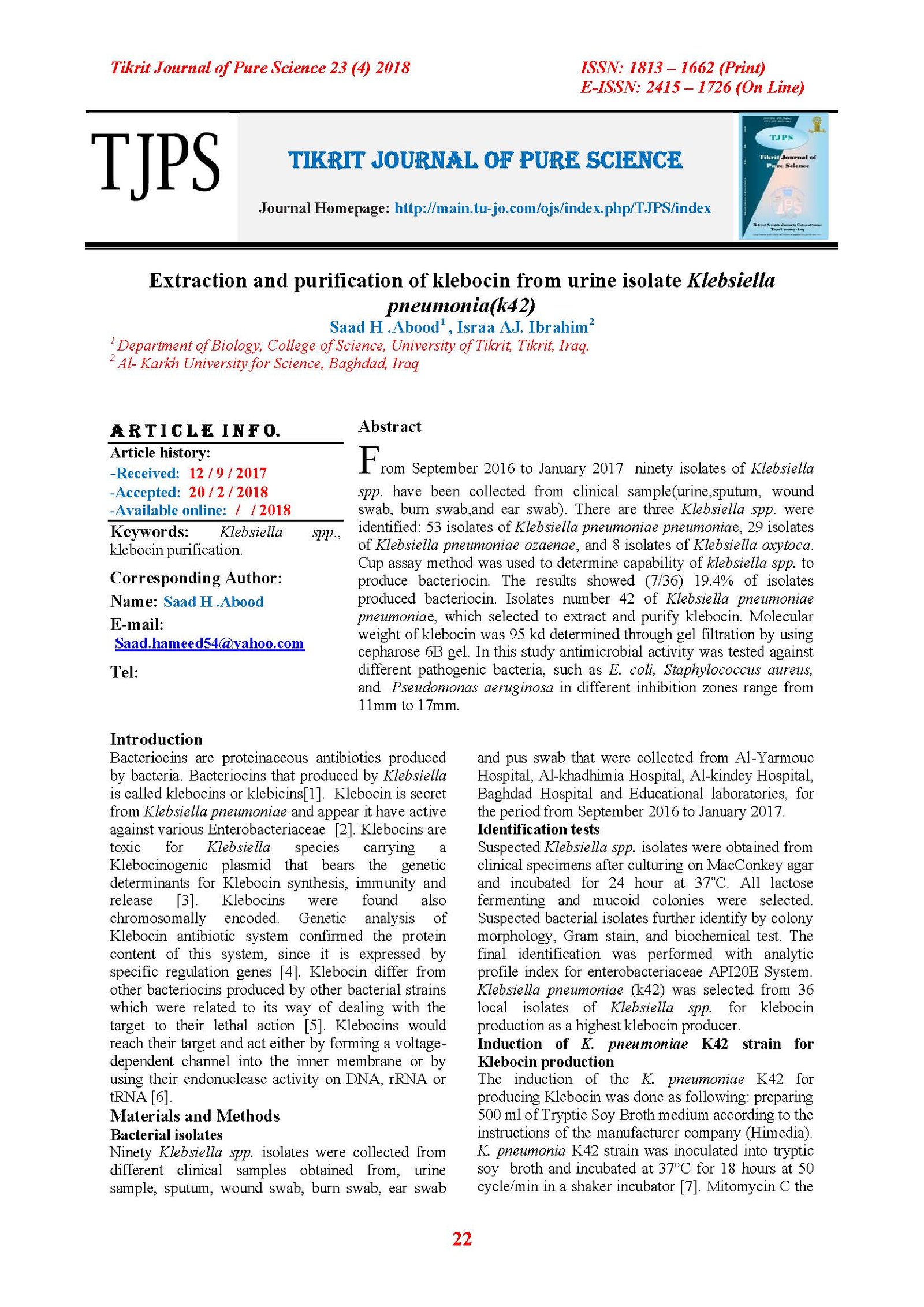Extraction and purification of klebocin from urine isolate Klebsiella pneumonia(k42)
Main Article Content
Abstract
From September 2016 to January 2017 ninety isolates of Klebsiella spp. have been collected from clinical sample(urine,sputum, wound swab, burn swab,and ear swab). There are three Klebsiella spp. were identified: 53 isolates of Klebsiella pneumoniae pneumoniae, 29 isolates of Klebsiella pneumoniae ozaenae, and 8 isolates of Klebsiella oxytoca. Cup assay method was used to determine capability of klebsiella spp. to produce bacteriocin. The results showed (7/36) 19.4% of isolates produced bacteriocin. Isolates number 42 of Klebsiella pneumoniae pneumoniae, which selected to extract and purify klebocin. Molecular weight of klebocin was 95 kd determined through gel filtration by using cepharose 6B gel. In this study antimicrobial activity was tested against different pathogenic bacteria, such as E. coli, Staphylococcus aureus, and Pseudomonas aeruginosa in different inhibition zones range from 11mm to 17mm.
Article Details

This work is licensed under a Creative Commons Attribution 4.0 International License.
Tikrit Journal of Pure Science is licensed under the Creative Commons Attribution 4.0 International License, which allows users to copy, create extracts, abstracts, and new works from the article, alter and revise the article, and make commercial use of the article (including reuse and/or resale of the article by commercial entities), provided the user gives appropriate credit (with a link to the formal publication through the relevant DOI), provides a link to the license, indicates if changes were made, and the licensor is not represented as endorsing the use made of the work. The authors hold the copyright for their published work on the Tikrit J. Pure Sci. website, while Tikrit J. Pure Sci. is responsible for appreciate citation of their work, which is released under CC-BY-4.0, enabling the unrestricted use, distribution, and reproduction of an article in any medium, provided that the original work is properly cited.
References
1-Hardgree,M.and Tu, A. (1988). Bcterial toxins: Handbook of natural toxins. Library of Congress publication ,United states of America.
2-Thomas, X.; Destoumieux-Garzon, D.; Peduzzi, J.; Afonso, C.; Blond, A.; Birlirakis, N.; Goulard, C.; Dubost, L.; Thai, R.; Tabet, J. C. and Rebuffat, S. (2004). Siderophore peptide, a new type of post-translationally modified antibacterial peptide with potent activity. J. Biol. Chem. 279.
3-Cascales, E.; Buchanan, S.; Duché, D.; Kleanthous, C.; Lloubès, R.; Postle, K.; Riley, M.; Slatin, S. and Cavard, D. (2007). Colicin Biology. Microbio. and Mol. Bio. Rev., 71 (1):158-229.
4-Nolan, E.; Fischbach, M.; Koglin, A. and Walsh, C. (2007). Biosynthetic tailoring of microcin E492m: post-translational modification affords an antibacterial siderophore-peptide conjugate. J.Am.Chem.Soc., 129(46):47-14336.
5-Hammami, R.; Zouhir, A.; Ben Hamida, J. and Fliss, I. (2007). Bacteriocin Characterization. BMC Microbiol., 17(7):89.
6-Chavan, M.; Rafi, H.; Wertz, J.; Goldstone, C. and Riley, M. (2005). Phage associated bacteriocins reveal a novel mechanism for bacteriocin diversification in Klebsiella. J.Mol.Evol., 60:546-556.
7-Chhibber,S. and Vadehra,D. (1989). effect of medium on the Bacteriocin production by Klebsiella pneaumoniae. folia.Microbiol.(praha). 34(2): 99-105.
8- Bauernfeind, A.; Petermüller, C. and Schnider, R. (1981). Bacteriocins as tools in analysis of nosocomial Klebsiella pneumoniae infections. J.Clinc. Microbiol., 14(1):15-19
9-Schutte,H.; Buchholz,R.; Gotz,P.; Schweizer,M. and Grafe,U. (1997). Isolation techniques. In: Methods in biotechnology (ed. H. Schmauder).pp.3-105 T.J. International Ltd., Britain.
10-Chhibber,S. and Vadehra,D. (1986). Purification and charechterization of Bacteriocin from Klebsiella pneaumoniae 158. J.Gen.Microbiol., 132(4): 1051-1054.
11-Gallucci, F.; Basile, A. and Drioli, E. (2002). Methanol as an energy source and/or energy carrier in
a-activity of klebocin againstS.aureusb-activity of klebocin against E.colia-activity of klebocin againstP.aeruginosa
a-activity of klebocin againstS.aureusb-activity of klebocin againstE.colic-activity of klebocin against P.aeruginosa
membrane processes. Separation and Purification Reviews., 36 (2):175-202.
12-Riley, M. and Chavan, M. (2007). Bacteriocins ecology and evolution. Springer-Verlag, London, United Kingdom.
13-Lagos, R.; Tello, M.; Mercado, G.; García, V. and Monasterio, O. (2009). Antibacterial and antitumorigenic properties of Klebocin E492, a pore-forming bacteriocin. Curr.Pharm.Biotechnol., 10(1):74-85.
14-Cavard,D. (2002). Assembly of colicin A in the outer membrane of producing Escherichia coli cells requires both phospholipase A and one porin, but phospholipase A is sufficient for secretion. J. Bacteriol., 184:3723-3733.
15-Aggarwal,S.; Khanna,S. and Arora,U. (2003). Charachterization, biotyping, antibiogram and klebocin typing of Klebsiella with special reference to Klebsiella oxytoca. Indian. J. Med. Sci., 57. Issue 2:68-70.
16-Pons, A.; Zorn, N.; Vignon, D.; Delalande, F.; van Dorsselaer, A. Cottenceau, G. (2002). Microcin E492 is an unmodified peptide related in structure to colicin V. Antimicrob. Agents Chemother., 46(1):30-229.
17-Riley, M. and Chavan, M. (2007). Bacteriocins ecology and evolution. Springer-Verlag, London, United Kingdom.
